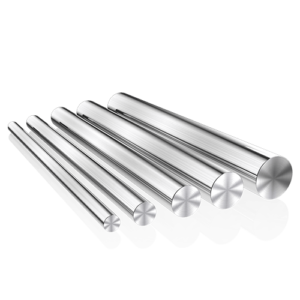Introduction

In the realm of manufacturing, the choice of materials is paramount to ensure the quality and durability of the end products. Among the plethora of options available, 304 stainless steel rods stand out as a versatile and reliable choice. Renowned for their corrosion resistance, durability, and aesthetic appeal, these rods find applications across various industries, ranging from construction to food processing. This blog delves into the manifold uses of 304 stainless steel rods, their properties, and why they are a preferred option in manufacturing processes.
Properties of 304 Stainless Steel Rods
304 stainless steel rods belong to the austenitic class of stainless steels, characterized by their high chromium and nickel content. This composition imparts remarkable corrosion resistance, making them suitable for use in diverse environments, including those exposed to moisture and chemicals. Additionally, 304 stainless steel rods exhibit excellent formability, weldability, and toughness, further enhancing their utility in manufacturing processes.
Applications in Manufacturing
The versatility of 304 stainless steel round rods lends itself to a wide array of manufacturing applications. From structural components in construction to precision parts in machinery, these rods play a pivotal role in ensuring the performance and longevity of diverse products. Some common applications include:
- Construction: 304 stainless steel round rods are utilized in the construction industry for structural support, reinforcement, and architectural embellishments. Their corrosion resistance makes them ideal for outdoor structures exposed to the elements.
- Machinery and Equipment: In the manufacturing of machinery and equipment, 304 stainless steel round rods find use in shafts, fasteners, valves, and various components requiring high strength and corrosion resistance.
- Food Processing: The hygienic properties of 304 stainless steel make it a preferred choice in the food processing industry. Rods are used in conveyor systems, storage tanks, and equipment where cleanliness and resistance to food acids are crucial.
- Automotive Sector: Within the automotive sector, 304 stainless steel round rods are employed in exhaust systems, engine components, and structural elements, benefiting from their corrosion resistance and durability.
- Medical Equipment: In the medical field, where hygiene and sterilization are paramount, 304 stainless steel round rods are utilized in surgical instruments, implants, and medical devices due to their biocompatibility and corrosion resistance.
Advantages of Using 304 Stainless Steel Rods
The utilization of 304 stainless steel rods offers several advantages in manufacturing processes:
- Corrosion Resistance: Exceptional resistance to corrosion ensures longevity and reliability, even in harsh environments.
- Hygienic Properties: Suitable for applications requiring strict hygiene standards, such as food processing and medical equipment.
- Versatility: The versatility of 304 stainless steel round rods enables their use across diverse industries and applications, contributing to cost-effectiveness and efficiency.
- Aesthetic Appeal: The attractive appearance of stainless steel enhances the visual appeal of products, making them desirable in various consumer-facing applications.
- Sustainability: Stainless steel is fully recyclable, promoting sustainability and reducing environmental impact in manufacturing processes.
Characteristics of 304 stainless steel

| Property | Description |
|---|---|
| Corrosion Resistance | High resistance to corrosion, making them ideal for applications in corrosive environments. |
| Strength | Good strength characteristics, ensuring reliability and longevity in various structural applications. |
| Formability | Excellent formability facilitates ease of fabrication, enabling the creation of intricate components. |
| Weldability | High weldability allows for seamless joining, contributing to the efficiency of manufacturing processes. |
| Temperature Resistance | Adequate resistance to elevated temperatures, suitable for use in both high and low-temperature environments. |
Conclusion
In conclusion, 304 stainless steel rods serve as indispensable components in manufacturing processes across numerous industries. Their exceptional properties, including corrosion resistance, strength, and formability, make them a preferred choice for a wide range of applications. From construction to medical equipment, the versatility and reliability of 304 stainless steel rods ensure the quality and durability of end products, underscoring their significance in modern manufacturing.
FAQ
Q: Can 304 stainless steel rods be used in outdoor applications?
A: Yes, 304 stainless steel rods are highly resistant to corrosion, making them suitable for outdoor use, even in harsh environmental conditions.
Q: Are 304 stainless steel rods magnetic?
A: While 304 stainless steel is not inherently magnetic, cold working or welding processes may induce some magnetism in the material.
Q: How do you clean and maintain 304 stainless steel rods?
A: Cleaning 304 stainless steel rods is typically done using mild detergent solutions and non-abrasive materials to prevent scratching. Routine maintenance helps preserve their appearance and properties.
Q: What is the difference between 304 and 316 stainless steel rods?
A: While both 304 and 316 stainless steel are austenitic grades, 316 contains molybdenum, providing enhanced corrosion resistance, particularly in chloride environments. 316 stainless steel is often preferred for marine and highly corrosive applications.
Q: Are 304 stainless steel rods suitable for welding?
A: Yes, 304 stainless steel rods exhibit excellent weldability, allowing for easy and efficient welding processes without compromising their corrosion resistance or mechanical properties.
With these key questions addressed, users can gain a deeper understanding of the applications and properties of 304 stainless steel rods.
